SPACE August 2023 (No. 669)
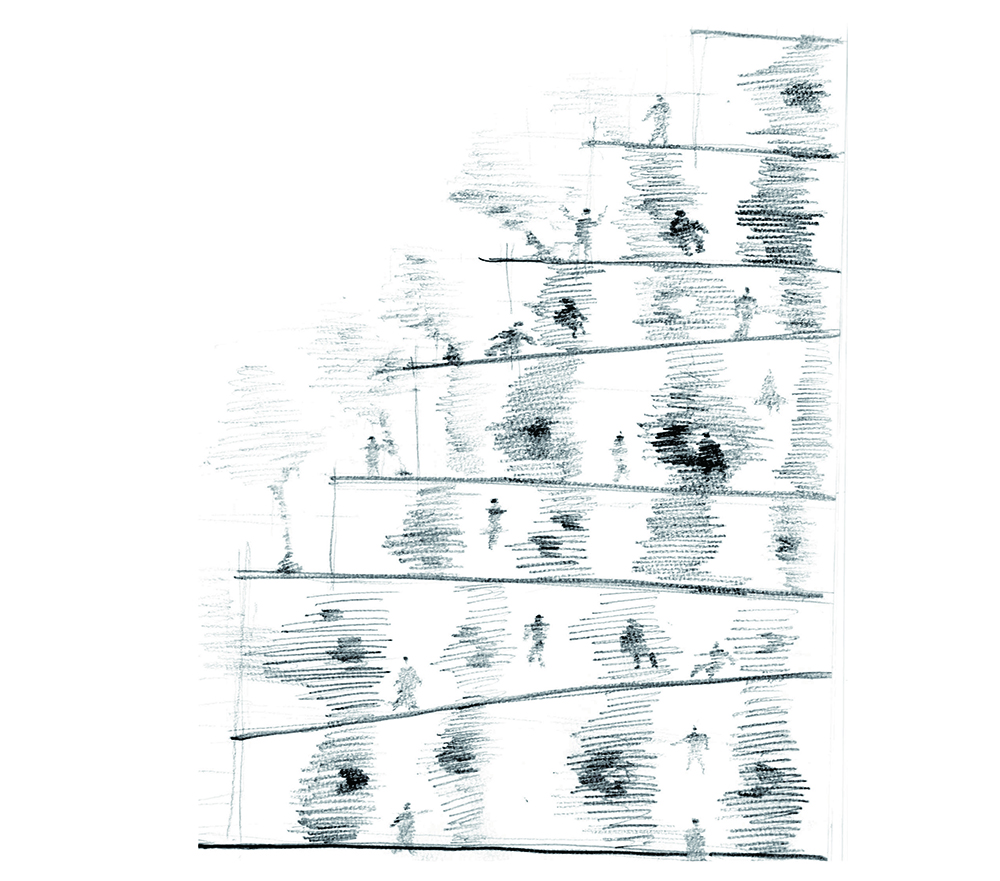
Concept sketch (Architectural Crag)
[ESSAY] An Architecture of Rawness
Architecture That Discovers the Self
I find myself practising architecture. As part of this practice, I try to contemplate the questions and creative thoughts behind the beliefs we take for granted. As much as possible, I make it a process of answering what I want to do, not what other people want to do. Conversely, I ask the same questions from the perspective of those who use the building: What role does my architecture play in helping people find themselves? What plane of relationship does my architecture place people on? Does it force people to conform to hierarchical and conventional structures, or does it support them to discover and strengthen their own desires and perspectives independently? Architecture should respect and activate each individual’s uniqueness in order to neutralise the other’s oppressive gaze. For this, architecture should be a place of singularity, where one’s own experience is possible in the here and now. Furthermore, architecture should provide opportunities for inhabitants to disrupt and reconfigure more conventional ways of living. Throughout this process, we may be confronted with moments where we rethink both the self and the everyday.
Extending Experiences Through Perception
The essence of architecture is to create a specific boundary around the human being and to inhabit it. Therefore, the nature of the boundaries plays a primary role in the formation of architecture’s experiential qualities. So how do we extend the experience of dwelling beyond familiar boundaries? Understanding and expanding how we perceive space is consequently linked to developing the dimensions of experience. I believe that experience in architecture occurs primarily in the intermediate space between subjective sensations and objective perceptions. The realm of perception is neither fixed nor clear-cut, leaving much room for ambiguity and interpretation, thus increasing the autonomy of the subject. However, in the process of perceiving nature or objects, when we understand the intrinsic power of the object or feel deeply connected to it, or when we have the experience of being integrated within nature (as a part of it rather than as an object of perception), we encounter an entity that exists beyond ourselves. These moments of perception cannot be clearly expressed in language but lead to a more profound self-awareness.
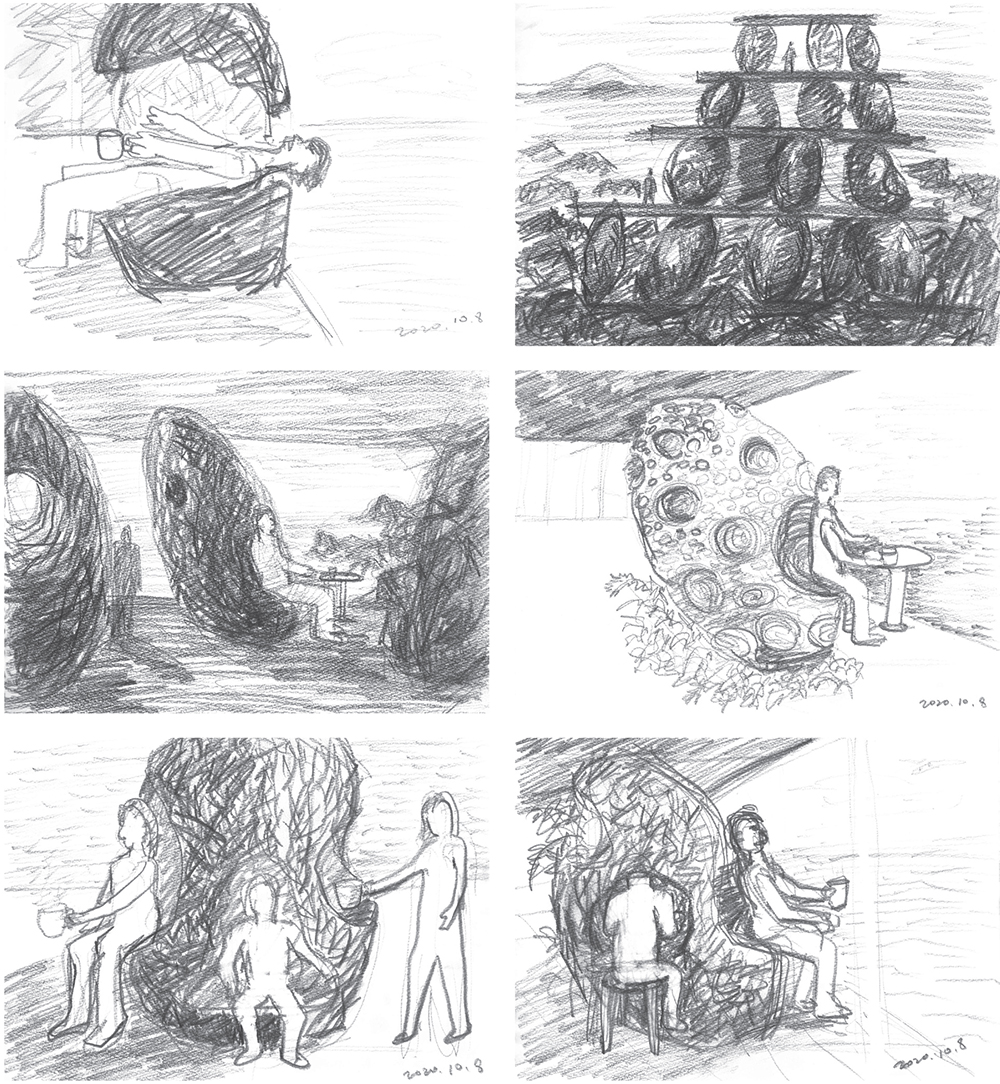
Jeong Euiyeob, Lost or Primitive series, Pencil on paper, 21×29cm, 2020
Where You Live and How You Visualise Space
We perceive the environment as an image, reconstructed according to our own context and interests. The image is not the object itself but the process of editing and formatting the material gathered by the senses in a certain way. The process can be called ‘imaging’, then a classic example of this is perspective. Perspective is one of the most common forms of imaging, not only in architectural representations but also in the perception of space. However, perspective is only one aspect of our real experience. The information our senses receive has no fixed vanishing point and is subject to many psychological influences that do not correspond to a set perspective. On the other hand, children’s drawings and traditional oriental paintings lack perspective, but offer visions of human sensations and appearances that perspective cannot capture. As this way of imaging is closely tied to the experience of space, it must to be reinvented to prompt new modes of building or living.
Painting and Architecture
After solving the logical or strategic problems of the building process, we encounter more ambiguous desires and sensations. This may not be an incidental part of the process, but an important one. In the process of building, many creative thoughts and images come into my head while I’m thinking. Many disappear, and only some make it into the building, settling as words, diagrams, and architectural elements. I was looking for a way of expressing a lot of impulses and ideas that are eliminated in this process. Because that’s what explains the motivation and context of the work. I try to draw what cannot be said but can be drawn, perceptions that are clearly present but cannot be held objectively. That may be what constitutes the real depth of my architecture. Some paintings are made before the design begins, some during the design, and sometimes after construction. Regardless of the order, the paintings fill the emptiness of a building that remains a shell after it is built. Perhaps this is because architecture needs a fictional truth amid a sense of loss, where anything can be built but nothing has to be. Architecture is always planned on the assumption that it will be built by someone else. Drawings are therefore stripped of their specificity, which can only be drawn at a particular moment, and paintings fill this gap. For me, paintings are texts that can either explain the architecture or stand on their own.

Jeong Euiyeob, Between a Plane and a Solid series, Acrylic on canvas, 34.8×27.3cm, 2022
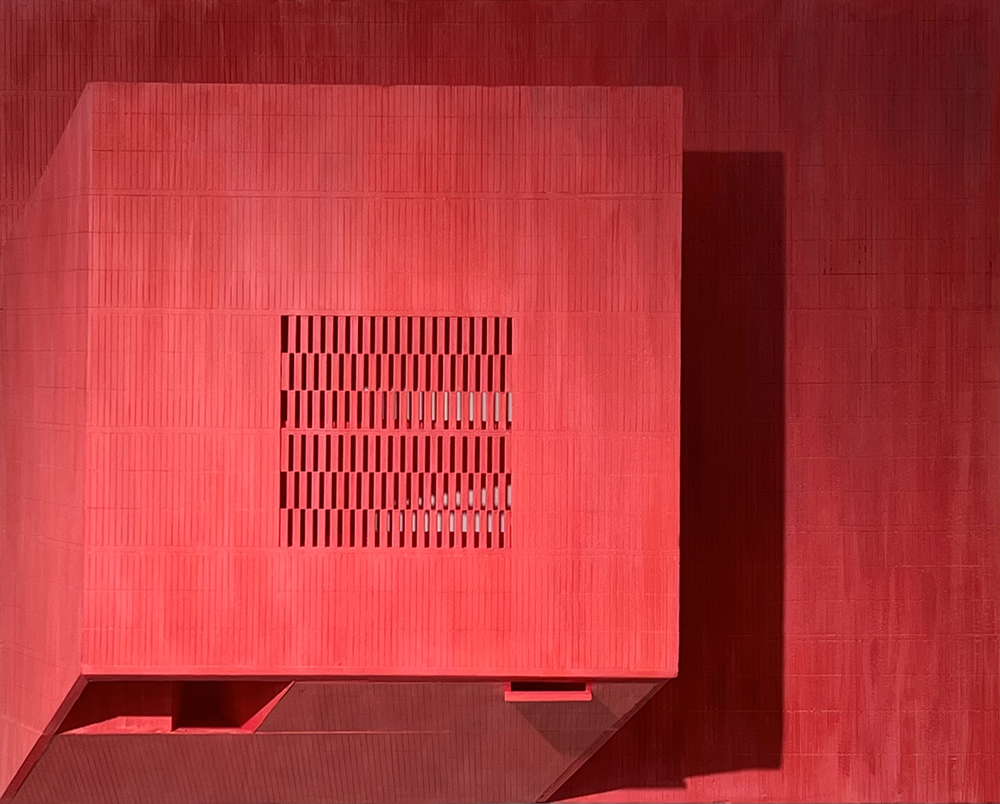
Jeong Euiyeob, Between a Plane and a Solid series, Acrylic on styrofoam, 100×80.3cm, 2023
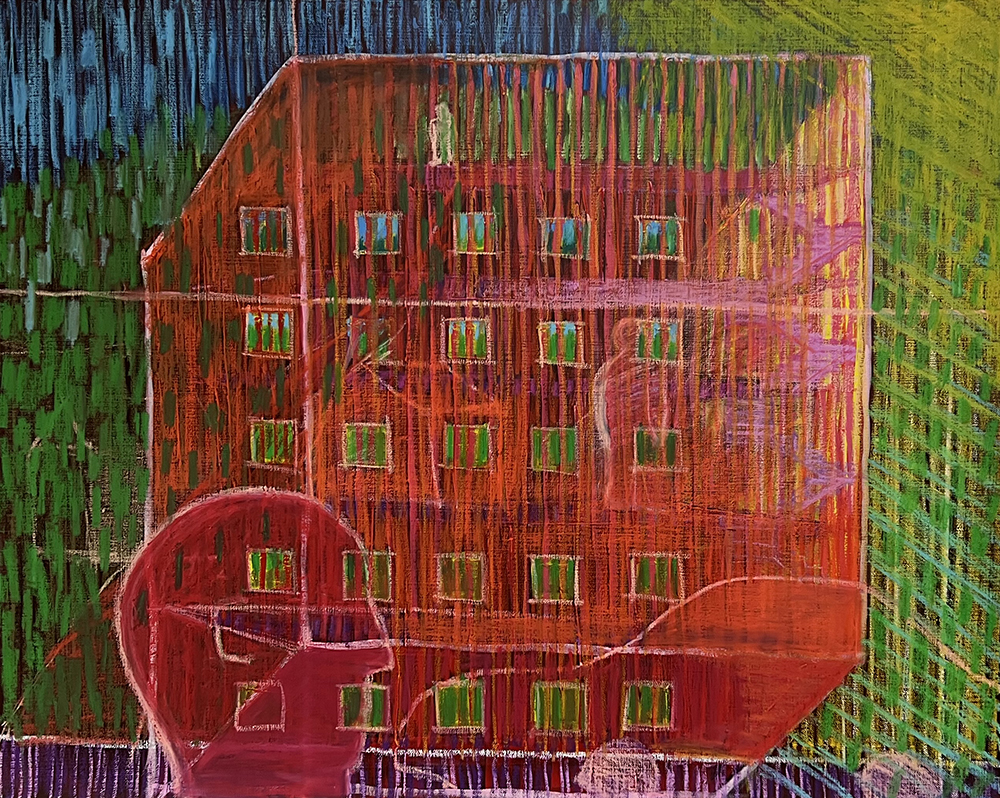
Jeong Euiyeob, Between a Plane and a Solid series, Acrylic and oil pastel on canvas, 90×72.2cm, 2022
A Primitive Perception
In the autumn of 2020, at the height of the Coronavirus Disease-19, I was taking a walk after a virtual class on Gapado Island, a small, flat island south of Jeju. There, where the skyline seemed parallel to the horizon in all directions, the vertically rising rocks on the seashore touched something inside me. I spent the rest of the day wandering the beach, touching, leaning, sitting, and lying on the surface, mesmerised by the strange shapes and holes that nature had created. The rock, formed when lava met water and hardened, must have stood there for aeons, battered by wind and waves. This ‘raw’ rock, a product of chance, without any intentional processing, surprisingly seemed like an exquisite and beautiful structure. The colours, patterns, textures, and constructive shapes of the rock, created over the course of an unimaginably long process, spoke to me, a relatively fleeting creature, about matter, space-time, and the movement of vast forces. The narrative of the rocks made me physically feel an intrinsic connection or unity between nature and myself. Looking back, I first experienced this raw, immersive experience during my rural childhood. As a child in a small town surrounded by mountains, the forest was a playground, a treasure trove, and a library. Once, I was lost in the deep woods of a dense mountain and found a cosy hollow among the trees. The trees surrounding the space were like a colonnade, their branches and leaves swaying in the wind, exquisitely framing the space like a wall, mysteriously scattering light. It was a moment when I perceived the trees differently. I stayed in that raw space for a while, forgetting that I was lost in the woods, and occupied it as my home. Later, I tried to find it again but never did. But the moment is still vividly imprinted on my mind.
The Recipe for Rawness
Time has passed, and I now spend my daily life in the city and connected to the network. It’s a world where our senses and even our unconscious actions become digital information that can be replicated and shared. However, I increasingly appreciate the raw experience of something unique, something that cannot be experienced indirectly and perhaps something that cannot be digitised. Just as advanced artificial intelligence can make us more conscious of what is human, the development of modern cities and digital technology can paradoxically bring out the most primal values and possibilities for rawness. ‘Rawness’ is not the unprocessed or natural, it suggests an object that reveals the nature of existence as it is and a perception that dislocates the object from established or narrow perceptions. As such, it is unfamiliar, but it makes us aware of ourselves and creates awareness of our relationship with others and the world. I built three structures which I thought of as ‘the recipe for rawness’ series, circulating the idea of rawness after 2020. MELTING HOUSE deals with a melting boundary, METABOX with a two-dimensional-like three-dimensional structure, and LOSTONE with primitive constructions. While the recipes vary from task to task, there are some common aspects. First, they reveal the inherent properties of the materials themselves. Second, they are constantly changing in relation to the forces of their environment. Third, they confront or expand the limits of human perception. Painting and architecture partially reveal the ‘rawness’ I pay attention to in my work. Some of this is present in the paintings, and some of it is present in the experience of the architecture. (written by Jeong Euiyeob)
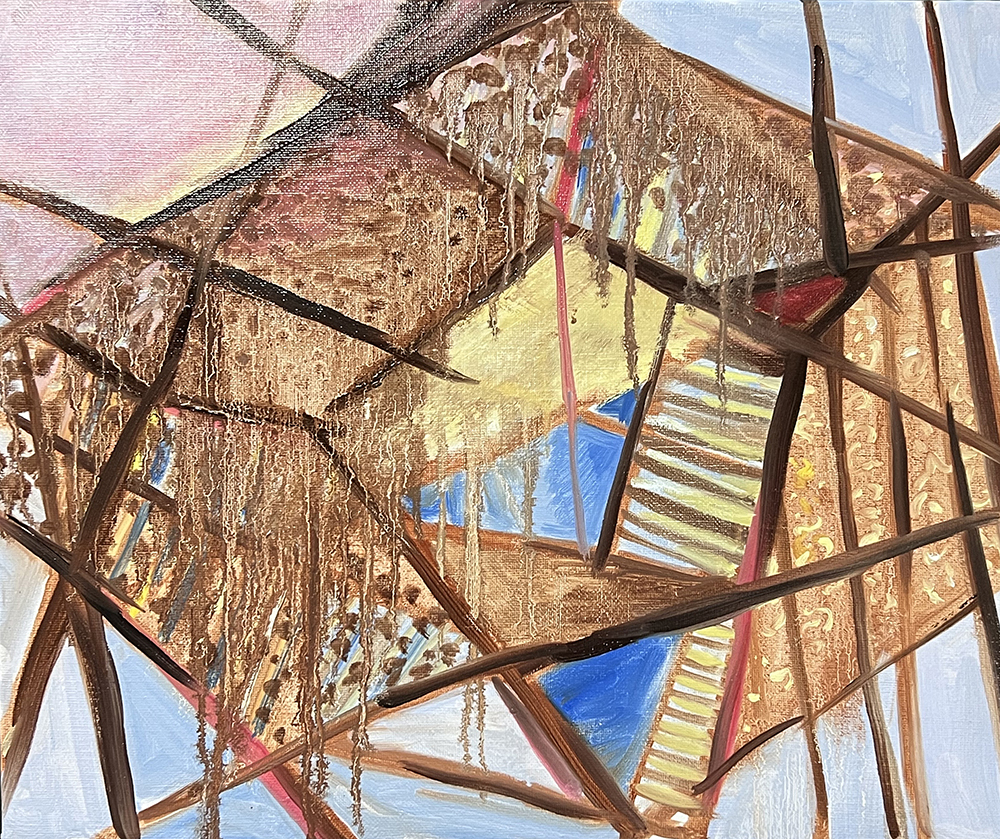
Jeong Euiyeob, Melting Boundary series, Oil on canvas, 33.4×24.2cm, 2022
You can see more information on the SPACE No. 669 (August 2023).





